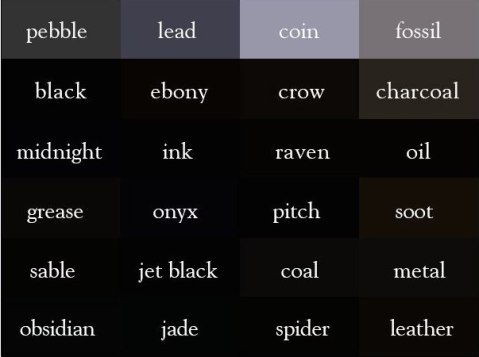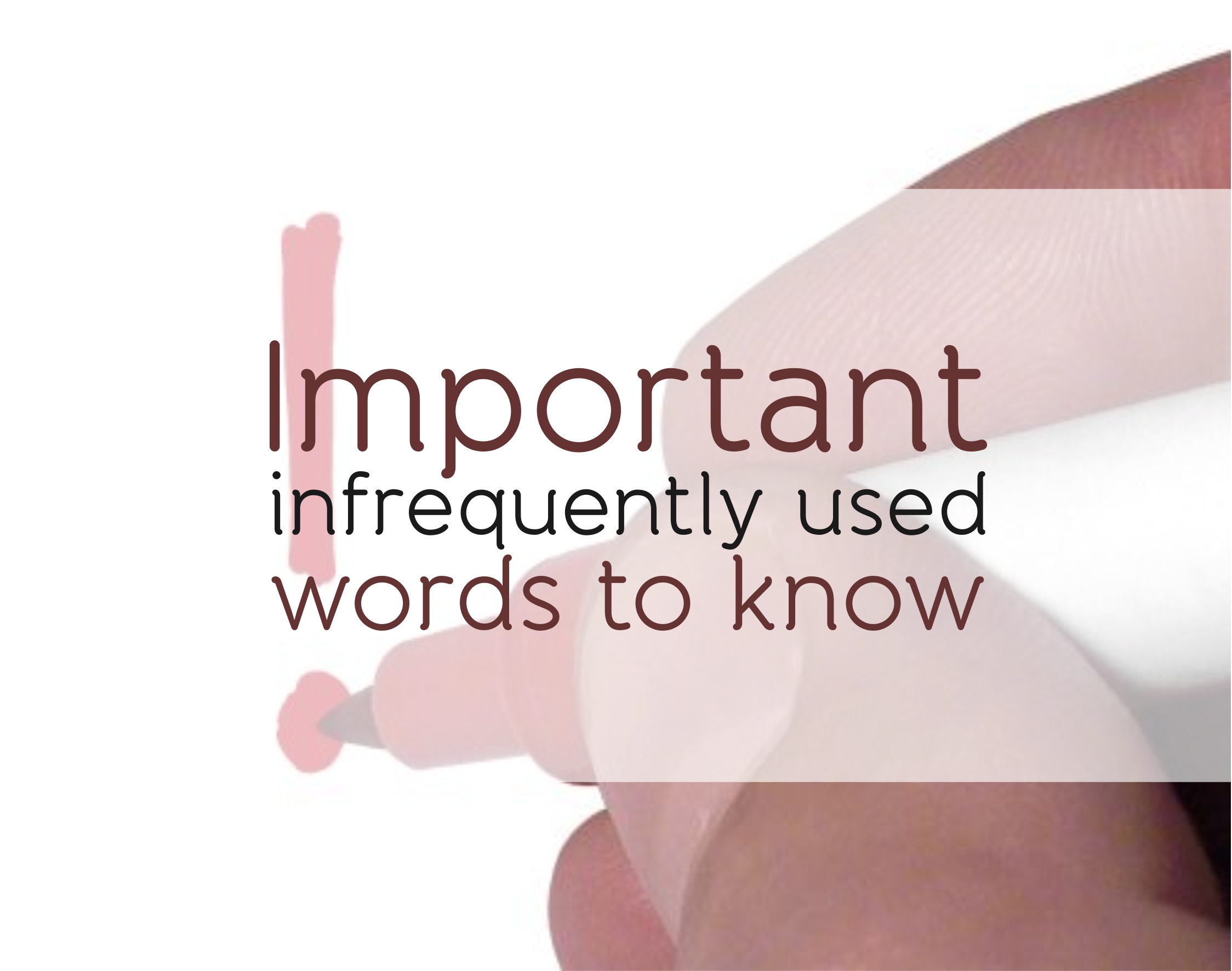Business Writing Truths and Myths

Written by Lynn Gaertner-Johnston, Syntax Training
For the 25 years I have taught classes in business writing, I have heard and rejected a few myths. And I have learned and applied some important truths. Don’t let yourself be fooled by false rules that others may follow. Recognize and apply what makes sense.
Is each of the five statements below a truth, a myth, or a mix of both depending on the situation? You decide. Read More…
240 color names in English
From snow to jade, if you are struggling to describe a color or you just want to broaden your vocabulary.
(Although the blacks seem all the same to me.)









Effective communication is “BRIEF”

We send and receive dozens of e-mails and have tens of conversations daily. More often than not one needs to read an e-mail thoroughly several times before understanding the actions needed or despite carefully listening the ramble of someone misses the point of the conversation.
“43% of people who received long-winded emails deleted or ignored them.”
Be more effective in your communication by following the BRIEF rule.
Fast Company have created the following formula for better communicating your information and/or needs:
B (Background): Provide a quick context—what happened beforehand?
R (Reason): Explain why you’re contacting them now— why should they engage?
I (Information): Give two to three pieces of information. What are the three main points or bullets of the topic?
E (End): Decide what do you want to be remembered. Tell the next steps – you will do what OR you expect the other site to do what.
F (Follow-up): Try to predict the questions asked at the end of conversation or (as a reply to the message) and prepare answers in advance.
Read why less is more HERE.
Deciphering the 123 Most Common Business Acronyms
By Kat Moon
Ever feel like your co-workers—or, worse, your boss—are speaking to you in a different language? No, I’m not talking about your team suddenly deciding to conduct a meeting entirely in French. I’m talking about what often seems to be the language of the business world: acronyms.
While some of us have the guts to ask for clarification when we have no idea what’s being said, others of us cringe at the thought of asking potentially “stupid” questions. Well, to everyone in the latter group: Today’s your lucky day. We’ve rounded up abbreviations for the most commonly used terms that you’re likely to run into at work (or more likely, in an email).
Better yet, they’re categorized by department, so you can prep before a meeting with your finance, technical, or marketing teams. (And because we’re pretty sure that, regardless of your role, you don’t want to be the only one who nods with a confused smile when there’s a RFD because the CTR for your website decreased and a QA test is required by EOD.)

GENERAL
BID: Break it down
COB: Close of business
EOD: End of day
EOM: End of message
EOT: End of thread
EOW: End of week Read More…
How to Spend Less Time Revising

Syntax Training
1. Make a simple plan and follow it. Diving in without a plan may give you a rush of accomplishment. But eventually you will have to slog through the revision stage, forcing your words and ideas into a coherent package.
Decide from the start what you want the message to accomplish. Examples:
- This agenda will help team members prepare for a productive meeting.
- This flyer will motivate parents to attend the open house.
- This email will help the customer complete the necessary paperwork.
Once you know what you want to accomplish, list the questions your message must answer for your readers to achieve your goal. Then write the piece by answering your readers’ questions. Do not include information that your readers would not ask for. If you do, you will write too much and will spend too much time cutting and revising.
For instance, an agenda that helps people prepare for a meeting might answer these questions:
- What are the agenda items?
- Who is responsible for handling each agenda item?
- How much time will we spend on each item?
- What do we want to accomplish with each one: to agree? to decide? to assign?
- How should I prepare?
Too often writers focus on background information, when readers rarely want or need it.
2. Use the power of one. When you write, limit yourself to one: just one topic per paragraph, one idea per sentence. Focusing on just one thing at a time will help you avoid sprawling paragraphs and sentences that you have to rework later.
For example, in a flyer to motivate parents to attend an open house, the answer to each of these questions would be a separate, short chunk of text:
- What’s this about?
- When is the open house?
- Where is it?
- Why should I attend? How will it benefit my family?
- Who will be there?
- Will food be served?
- Do I need to let anyone know that I plan to attend?
- Where can I get more information?
Combining the answers to several questions in one chunk of text will tangle the message. And it will require more time to revise.
Similarly, a sentence with several interwoven ideas will take time to untangle:
This version, with one idea per sentence, is simple and clear:
Even better, this version helps the ideas stand out for quick action:
- Provide a copy of your exempt sales tax document.
- Fill out the top and signature portion of the credit application.
If you limit yourself to one idea per sentence (or bullet), you will write a clear version from the start. The time you spend rewriting will shrink.
3. Recognize that perfection is unattainable—and a waste of time. Unless you write essays, poetry, or other literary works, your audience will not read and savor your every word. Instead, they will skim the agenda, flyer, email, proposal, report, or other communication in search of the information they need. So why strive for perfection when clarity, conciseness, and courtesy are useful, achievable goals?
Avoid pointless revising:
- Don’t fuss over changing “interesting” to “notable” unless “notable” is more accurate.
- Don’t take time to change “Thanks” to “Thank you” unless your reader needs a more formal tone.
- Don’t struggle to eliminate “I am writing to” at the beginning of an email. Yes, your reader knows you are writing. But there is no harm in stating “I am writing to inform you of a change in your interview schedule.”
- Don’t strive to revise just because two sentences in a row begin with “I.” Those two “I”s will not distract your reader. (But starting every paragraph with “I” willdistract your reader, who is probably skimming at the left margin.)
- Don’t take time to apply outdated rules. You can start a sentence with any word you choose. You can end a sentence with a preposition. You can use contractions unless your document must be formal.
When your communication focuses on its goal and answers your readers’ questions in clear sentences and paragraphs, you are finished revising. Just run your grammar and spelling checker; then proofread. Hurray! The piece is done! Now move on to the next one.
No more boring sentences
I don’t know if it’s just me, but it seems like we, as writers, do get so wrapped up in the actions, thoughts and relationships of our characters that we completely forget to dress it up. Sentences get so long-winded in action and thought that any descriptive narrative is just left in the dust. With this tutorial, we will remedy that. Hopefully.
You may ask: What am I to do? And I shall tell you: You just need to start small, using basic descriptive words and work up to more complicated and sophisticated sentence structures.
- Let’s start with a plain, basic sentence.
Ollie sat underneath the tree.
- Let’s replace Ollie with a pronoun and give the tree a species.
A boy sat underneath the willow tree.
- Ask yourself this. How old is the boy? Is he very young? Or is he more of a teen? Is the tree dying? Is it a young tree? Use words like “young” or “lively” to give your character (or any other living things in the scene) an age group and a starting point to visualizing your character for the reader. We’re just going to call the boy “young” for right now.
A young boy sat underneath the willow tree.
- Now we need some sort of action the boy (or the tree) could be doing. just sitting isn’t going to cut it. when adding more action to a sentence, it would range anywhere from a single word to an entire phrase. just make sure that when you add the action that it moves with the rest of the sentence in a coherent fashion and that there is proper punctuation to accommodate it. for our little example sentence, we’re going to add a phrase.
A young boy sat underneath the willow tree, watching a breeze.
- “Watching the breeze” sounded all nice and fluffy when we first put it, but after we’ve read it a few times it sounds sort sort of ridiculous. One can’t literally watch a breeze, right? Here we can just add an action for the breeze to be doing simultaneously with the action of the boy. The boy doesn’t even have to have any awareness of what the breeze is doing at all. So, we will just change a few words around and add something for the breeze to do.
A young boy sat underneath the willow tree, as a breeze flitted through the bulrushes.
- Now that you are starting to get the hand of this, we can just skip a bunch of the steps and get to the end part, where we have a lovely and descriptive sentence worthy of opening your post. Below, as you can see, we added a few more choice words, replaced some things and moved some phrases around.
As a gentle breeze flitted through the bulrushes, a young boy sat contemplating underneath the ancient willow tree.
How to write much better
or not.
1. Avoid alliteration. Always.
2. Prepositions are not to end sentence with.
3. Avoid clichès like the plague (They’re old hat.).
4. Eschew ampersands & abbreviations, etc.
5. One should never generalize.
6. Comparisons are as bad as clichès.
7. Be more or less specific.
8. Sentence fragments. Eliminate.
9. Exaggeration is a billion times worse than understatement.
10. Parenthetical remarks (however relevant) are unnecessary.
11. Who needs rhetorical questions?
























